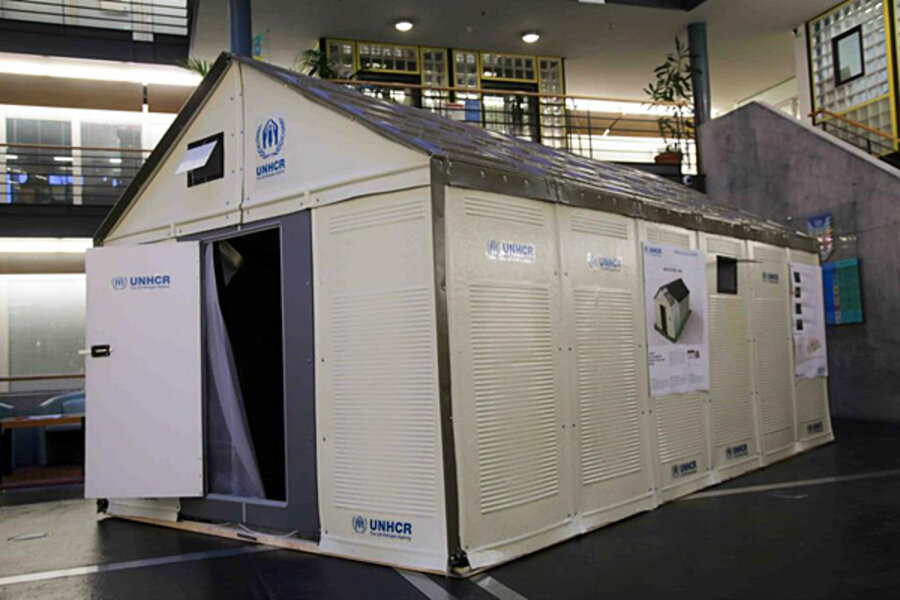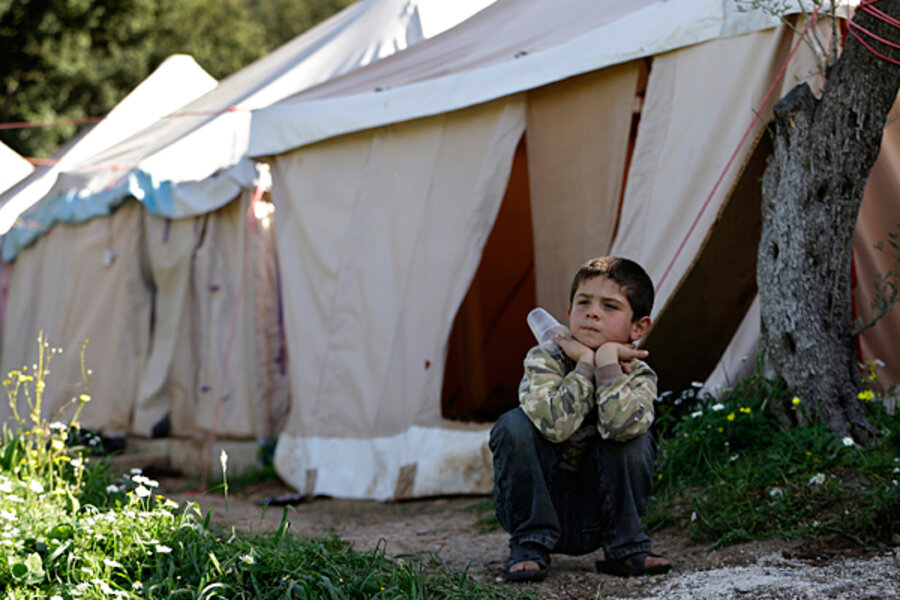Why do we still put refugees in tents? IKEA has a new idea.
Loading...
| Boston
Nothing says misery like a hot tent in a refugee camp. That's especially true when a family spends year after year under a triangle of canvas meant to last only six months.
More than six decades after the United Nations passed a convention pledging to protect refugees, very little has changed about the way they are sheltered – until now.
The IKEA Foundation, the philanthropic arm of the iconic Swedish furniture maker, has helped come up with a more comfortable refugee shelter. Just like the coffee table or nightstand sitting in your home, the IKEA shelter is flat-packed, requires no tools to assemble, and can be taken apart and rebuilt again elsewhere. Instead of canvas flaps, the shelter is made up of hard panels, which stand up better against harsher climactic conditions and offer more privacy.
The clever innovation heralds a new era of refugee assistance, one where the United Nations approaches the private sector for ideas and investment, not just donations. If the shelters work, the design will be made available by IKEA to other companies for commercial production, while the swelling numbers of refugees from conflicts like those in Syria will have a more humane place to call home.
“We’ve been working on this for three years and it’s… a significant investment,” says Per Heggenes, the CEO of the IKEA Foundation. “[W]e hope that this will be a product that can be manufactured commercially and offered in the market to all organizations that are dealing with emergency and disaster situations.”
Beyond tents
An estimated 3.5 million of the world's refugees – civilians driven from their homes and across international borders by conflict – are living in tents.
Searching for a better alternative, the Refugee Housing Unit, a Swedish design firm specifically aimed at improving the living conditions of displaced persons, approached the IKEA Foundation in 2010. Intrigued by the idea, IKEA reached out to the United Nations High Commissioner for Refugees (UNHCR) and the initiative was born.
Each of the IKEA shelters is designed to house one family. The shelters employ technologies to keep the interior cool by day and warm at night; a solar panel on each provides electricity.
“The new shelter has the potential to provide a more dignified temporary housing solution to refugees,” said Olivier Delarue, UNHCR's senior adviser on private sector partnerships, in an e-mail. “Essentially it could be a temporary home until people are able to return to their place of origin.”
The full range of benefits – and drawbacks – will not be completely known until the prototype goes into field testing next month. Several units of the shelter will be introduced to the Dollo Ado refugee camp in southeastern Ethiopia, which houses approximately 190,000 Somali refugees. The site was chosen in part because of its harsh conditions.
"It is critical to set the units in a harsh environment to have feedback on their technical resistance,” says Mr. Delarue, “and also [to] have refugees’ views on the cultural suitability of the units.”
The testing phase is supposed to take between four and six months, during which time adjustments will be made before the shelter goes into production. Until then, it won't be known whether the shelter will be suitable for the needs of those living in camps.
"We don’t know enough to [say] whether it is an ideal solution yet,” says Prof. Alexander Betts, an associate professor at the University of Oxford's Refugee Studies Centre and the director of the Humanitarian Innovation Project. But he adds, “there are reasons to believe it’s exciting: The idea of moving beyond the usual tent structures … that often characterize that sort of terrain in the Horn of Africa, to provide something more durable, more sustainable.”
The shelters are more costly than typical refugee housing, but if enough are produced then the cost will be lowered to just above the price of tents, and they last up to six times longer.
Coming soon to a border near Syria
However, this process may be sped up in order to help ease the pressure of continued refugee flows out of Syria.
“We have also been testing the shelters in Iraq and Lebanon,” says IKEA's Mr. Heggenes. “[We] decided to move from just testing it in Dollo Ado to testing it in all three areas, at the request of [the] UNHCR because the needs are so great in and around Syria.”
Over the past two and a half years, the civil war in Syria has produced 1.6 million refugees, most of whom have taken shelter in neighboring Iraq, Jordan, Lebanon, and Turkey. The strain of supporting the displaced Syrians is immense, with the UN recently asking for a record $5.1 billion. Organizations such as the UNHCR are looking for innovative ways to handle these emergency situations.
The IKEA Foundation is currently the single largest private donor to the United Nations ever, and their contribution has created the groundwork for more innovative ways of approaching refugee management issues. The Dollo Ado camp serves as a sort of laboratory, where IKEA can question and potentially improve upon the services and solutions normally applied to refugee emergencies.
“[A] foundation like ours, we can afford to take risks, so we can go when we see the opportunity,” says Heggenes. “We can go invest in a product like this and maybe change the way we look at emergency housing in the future. The potential of this is huge.”
Great potential, possible pitfalls
The partnership with IKEA marks a new phase of UNHCR-private sector relations. "It also potentially moves the whole way in which we look at refugees from one of a logic of charity to that of a logic of sustainability," says Prof. Betts.
But, as Betts cautions, wider engagement with the private sector comes with its own risks, especially when introducing them to vulnerable populations such as refugees.
"If one had private sector companies working [in] camps for the wrong motives, who didn't respect human rights or protection needs, that would be extremely problematic and would seriously undermine the UNHCR's ability to ever work with the private sector again."
Though Betts does not think this is the case with IKEA, he recommends that if the UNHCR’s engagement with the private sector continues, regulations should be set up, such as a voluntary code of conduct.
"It can be very exciting, it can make a contribution, but it must be done in the right way."








